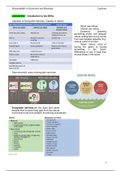Sustainability in Economics and Business Lectures
Lecture One – Introduction to the SDGs
Valuation of Ecosystem Services: Classes of Values
- Direct use values
- Indirect use values
- Existence (knowing
something exists) and bequest
values (willingness to pay comes
from less tangible aspects). E.g.
cultural value of a forest.
- Option values: value of
having the option of having
something in the future.
Willingness to pay in case they
choose these in the future.
Total economic value of ecosystem services:
Ecosystem services are the many and varied
benefits that humans freely gain from the natural
environment and from properly-functioning ecosystems.
1
,Sustainability in Economics and Business Lectures
Sustainable development is the kind of
development that “meets the needs of the
present without compromising the ability of
future generations to meet their own needs”
Key concepts of sustainable development:
1. The concept of "needs" in particular the
essential needs of the world's poorest
people, to which they should be given
overriding priority;
2. The idea of limitations which is imposed by
the state of technology and social
organization on the environment's ability
to meet both present and future needs.
Unsustainability: planetary boundaries.
Tragedy of the commons is a situation in a
shared-resource system where individual users,
acting independently according to their own self-
interest, behave contrary to the common good
of all users by depleting or spoiling the shared
resource through their collective action.
Tragedy of the horizon: climate change is a tragedy
of the horizon which imposes a cost on future
generations that the current one has no direct
incentive to fix.
2
,Sustainability in Economics and Business Lectures
Theoretical framework
• Tragedy of the commons and of the horizon are behind the problem of unsustainability
• No common theoretical framework regarding sustainability due to the multidisciplinary
nature of the problem
• Different perspectives
Macro vs. Micro
• Global
• Regions/blocs
• Countries
• Industries
• Firms
• Households
Footprint
There is an ecological deficit if the footprint exceeds biological
capacity, if it is the other way round, the country (...) has an ecological
reserve.
- Measure in hectares of biologically productive space with
- World average productivity.
- Measures how much land and water area a human population requires to produce the
resources it consumes and to absorb its wastes under the prevailing technology .
- At the individual level, firm level, industry level, country level.
- For total biological capacity, cropland, pasture, forests, fisheries, built space and energy are
taken into account.
- Footprint varies with population size, per capita consumption and the resource intensity of
the prevailing technology.
- WWF et al. (2006) allocate 1.8 global hectares per person to ensure
ecological balance. That is, consumption is sustainable when the
footprint is not above this amount.
- Countries with a large footprint are United Arab Emirates, United
States, Kuwait, and Canada.
- The footprint is smallest in Bangladesh, Benin, Cambodia,
Mozambique and Nepal.
Alternative Measure: Ratings
- Compare Credit Ratings (“AAA”; Moody’s, Standard and Poor’s)
- Different providers; focus on environmental and social policies and performance, as well as
governance; hitherto/until now ESG (Environmental, Social & Governance) instead of
sustainability.
- Lack of transparency (‘secrets of the trade’).
- Different measurement and scope of the rating, as well as rater bias.
SDGs
The meaning of sustainable development evolves over time
3
, Sustainability in Economics and Business Lectures
•
Transformations
Sachs et al. define in their article six transformations. We propose six integrated transformations
that together can achieve the 17 SDGs and foster greater coherence across governments,
business, and civil society. Science has a big role to play to design and implement these
transformations. As governments are unclear about how to operationalize such a complex
agenda. We identified the most critical interventions needed to achieve each SDG, rating their
contribution on a scale
of 0 to 3.
4




